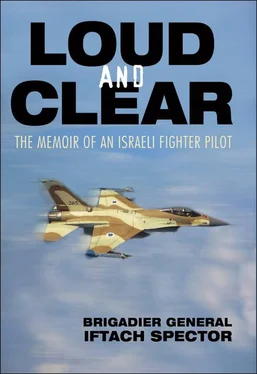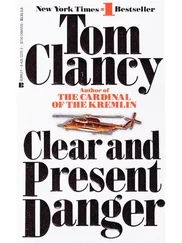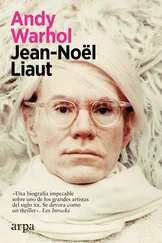It seemed that every sentence here had to end with an exclamation point.
We were pushed inside, one after another, and on entering, scanned the room. This was the squadron briefing room, the heart of its existence. The room had a large central table, covered with maps of the Middle East. Around the table, leaning against the walls, sat twenty or so pilots of the elite jet fighter community. We realized that they had all come here to welcome us and to get to know the trainees.
I looked at the men cautiously, surreptitiously. The first impression was one of—a festival of mustaches! Almost everyone here sported one: Yalo’s clipped mustache was next to David Ivry’s Cossack-style flowing yellow one. A black enormous mustache on Beit-on’s upper lip contrasted with the two red brushes sported by Nissim and Yozef Salant. And the cat’s whiskers mustaches that belonged to Aki and Avihu were better than the blurry shadow on Khetz’s beak. Mustaches and more mustaches. They surrounded us challengingly. Oh, my God, I thought, awestruck. We trainees hadn’t much to add to the glory of the Scorpions in this respect, even if you considered the yellow thread under Goldie’s nose. And what’s more, though ZBB’s and Umsh’s cheeks were shadowed, Sheani and I had no hope: the shrubbery hadn’t even begun to grow.
I scanned the unknown faces, searching. Who among them was Yak?
However, Zorik was the dominant figure. His sharp eyes searched the room; he decided, enough, and banged the table with a heavy fist. Silence. Then he addressed the new arrivals. The introduction ritual had begun. Each of the trainees was invited to stand up in turn and introduce himself to the group.
After much pushing and shoving, Umsh got to his feet. He was two or three years older than the rest of us. Black-haired, virile, tall, and athletic, Zvi Umshweiff was the handsomest guy in our group. He towered over the rest of us.
When Umsh began talking, I looked again to try to spot Yak. A character, Yak was the one whom air cadets discussed admiringly as “the best fighter pilot in the history of the IAF.” Recently, while in the operational training stage, we were given the manual on aerial combat theory. Yak had written this manual. I spent nights on the crude but clear sketches he drafted there—an aircraft gets on his adversary’s tail, and suddenly, as in a sophisticated jujitsu exercise, is catapulted forward, instantly transformed from predator to prey. And, of course, Yak was one of the very few in the world who had shot down MiG-17s, the most modern jet fighters built in the USSR. Yakir Laufer, the ex-mechanic who knew everything, said that nobody in the world could sit on Yak’s tail. And then he would add humbly, “for now.” This naive arrogance—which, as we advanced in our training, was gradually proving itself true—annoyed the rest of us.
Yak was already nearing the end of his command of the Scorpions. His successor, Maj. Shimon Ash, joined us in the conversion course on the Super Mystere, and he also was watching us, but Zorik, the vice commander, was the boss. Still, I knew that Yak was hidden among the men, and he was the player who would separate the sheep from the goats. Whoever he didn’t like would wash out and go back to the old planes, the Mysteres or the Ouragans.
So, I wondered, who was Yak?
THERE WAS SOMETHING ODD about Zvi Umshweiff, some internal conflict that endowed him with an enigmatic, mysterious aura.
His strange family name—Umshweiff—reeked of terrible and evil places. But in spite of this, there was no trace of the Diaspora in him. On the contrary, Umsh was the perfect Sabra, a kibbutz product, full of smiles, a good dancer, and a superb athlete. There was no hint of a Polish accent in his speech, but we all could sense ghosts shadowing him. Slowly and gradually we learned some details. He had come from Umshweiff—a village near Auschwitz—and he had spent two years in the extermination camp as a child, lost both parents, and somehow, by a miracle, made it out alive. When World War II ended, the nine-year-old boy wandered the roads of Europe and eventually arrived in Palestine and Kibbutz Ein-Hamifratz near Haifa. There he grew up an orphan.
In those years, the 1950s, such a story was not very unusual. The classrooms were filled with children who came from God knows where, speaking foreign languages. Gradually a perfect, throaty Hebrew replaced Zvi’s native Polish. The Holocaust seedling grew, acquired a tan, and became a superb sportsman and an excellent student. That is what Zvi Umshweiff let us know about him, that and nothing more. But when they ordered us to change our family names to Hebrew ones, Zvi stubbornly refused to part with his strange name.
In our cadet barracks and on some hard marches he proved a good friend. One evening on the “hunger hike,” when the night had enveloped our small group on top of a hill in the Negev desert, and we lay on the ground shivering, weak from three days of marching with no food, suddenly Umsh spoke up.
He proposed a prize of ten pounds from his own pocket to whoever could fart the smell of fried chicken. The contest aroused new spirit and got a good laugh from all of us. Zvi was a good sport, but he still jealously guarded his privacy. He always played his cards close to the chest. He was not unsocial, but kept to himself, meticulously squared away, ironed and shined. He lived the moment, every moment, as if it were his last. When we started flying he was immediately successful, but was satisfied with whatever he did and didn’t strive to do better. He studiously avoided any extra effort.
On one occasion when he did go out of his way, he took me with him.
We were learning the basics flying Harvard trainers. Suddenly Zvi took me aside and challenged me to a one-on-one aerial combat—a dogfight. We stood away from the others, whispering together worriedly, because this idea was mad and criminal. At that time we were just at the initial stage of our solo flights, and were only beginning to get a preliminary understanding of how to manipulate the controls of our chubby propeller trainer. Naturally, none of us had any clue whatsoever as to the real meaning of those two words “aerial combat” and what happens in one. And above all, it was clear to us that what was cooking between us was a very serious offense against army regulations. We knew that if anybody even heard us talking we would instantly be washed out of the course, and the school’s commander would definitely lock us both up.
We were just looking for big trouble.
THE NEXT MORNING we met over the eastern edge of the deserted British runway at Faluja, where nowadays stands the town of Kiryat Gat. At that time there was only the open expanse of the northern Negev Desert. I held a left-turn holding pattern and waited for Zvi’s arrival.
The Harvard trainer that came toward me rocked his wings and blinked twice with his landing lights. I extended my landing gear and then retracted them, as a signal. The area around us was clear and no other plane was in sight, so I went to full throttle and flew right at him, not knowing what exactly to do next. His barrel-round nose turned toward me, and within a minute we found ourselves chasing each other with roaring propellers. The more I tightened my turn, the more he tightened his, and the circle shrank and shrank. I could see his face as a white mark in the frame of his glass canopy.
We continued this way until I lost my temper and pulled back hard on the stick. My airplane began to stall, shuddering and skittering from side to side, like a car on a wet road. For some reason, Umsh’s plane had stopped turning and was flying straight ahead. Had he given up? Had I won? With pounding heart I hurried to complete the rest of the turn and came in on his tail, disregarding the shuddering of my Harvard, which was threatening to stall again under the pressure of the pulled-back stick, chattering victoriously “Rat-tat! Rat-tat!” And then I sensed something else, big and gray, moving ominously at the fringe of my vision. A second later I passed a rocky hillside within a whisker of my right wing.
Читать дальше












